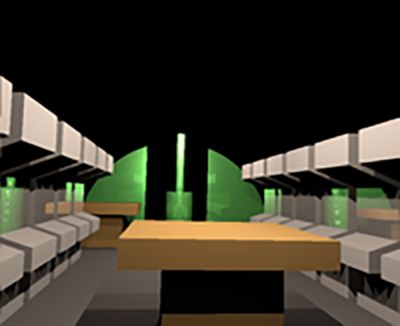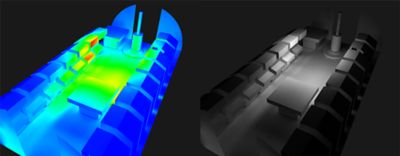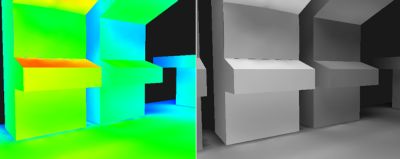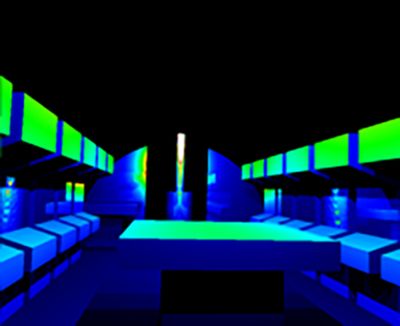-
United States -
United Kingdom -
India -
France -
Deutschland -
Italia -
日本 -
대한민국 -
中国 -
台灣
-
-
產品系列
查看所有產品Ansys致力於為當今的學生打下成功的基礎,通過向學生提供免費的模擬工程軟體。
-
ANSYS BLOG
January 10, 2019
Safe Lighting Design of a Submarine Control Room
It gets pretty dark underwater. That’s why engineers need to ensure proper lighting design in a submarine control room.
Submarines typically operate in three different lighting conditions:
- Normal lighting — Where the submarine control room is fully lit with LED or fluorescent lights.
- Night lighting — Where the ship dims the lights, or switches to red or blue lights, to help naval officers adjust to darker conditions and maintain healthy circadian rhythms.
- Full darkness — Where the ship goes completely dark to prevent internal lights from interfering with the periscope.
Simulation of the illumination of a submarine control room with all lights on.
Ansys optical simulations help engineers ensure the lighting in submarine control rooms is safe and ergonomic.
Thanks to Ansys Speos’ human eye model, these simulations will give engineers an accurate representation of what the submarine control room will actually look like.
How to Simulate the Lighting Design of a Submarine Control Room
The first step is for engineers to import the geometry of the submarine control room into Speos. In this case, a simplified geometry of a control room is used.
The next step is to define all materials in the model. From there, engineers can start defining light sources within the control room.
The goal is to ensure the homogeneity of the illumination within the control room, while reducing glare, reflections or other lighting conditions that can negatively affect the human eye.
Simulation of the illumination of a single light in a submarine control room. The simulation is depicted in false colors (left) and grayscale (right).
Simulating each light in the control room one at a time can help engineers determine which shadows and reflections are cast by which light. In the above simulations, you can see that this particular light creates reflections and shadows on the floor of the control room.
Lighting Ergonomics of a Submarine Control Room
The ergonomics of a monitoring station is limited if its screen shows glare. Glare can limit an officer’s ability to assimilate the information displayed on the screens. To eliminate glare, engineers must perform a closer inspection of the lighting around a monitoring station in the submarine control room.
The scenario can be rendered within a real-time virtual environment, so engineers can track what a naval officer would see if they were walking near, or working at, a monitoring station.
Simulation of the illumination of a single light in a submarine control room focused on a monitoring station. The simulation is depicted in false colors (left) and grayscale (right).
After each light is optimized for the control room and the monitoring stations, it's important that engineers assess the lighting ergonomics of the complete environment.
In other words, it’s time to simulate all the lights at once. This is the best way to test and optimize the homogeneity of the light within the control room.
Once the assessment is completed for normal lighting conditions within the submarine, the engineer will have to repeat the process for night lighting conditions.
Simulation of the illumination of a submarine control room with all lights on. The simulation is depicted in false colors.
Learn more about Ansys Speos, or try it for free with a free 30-day trial!














